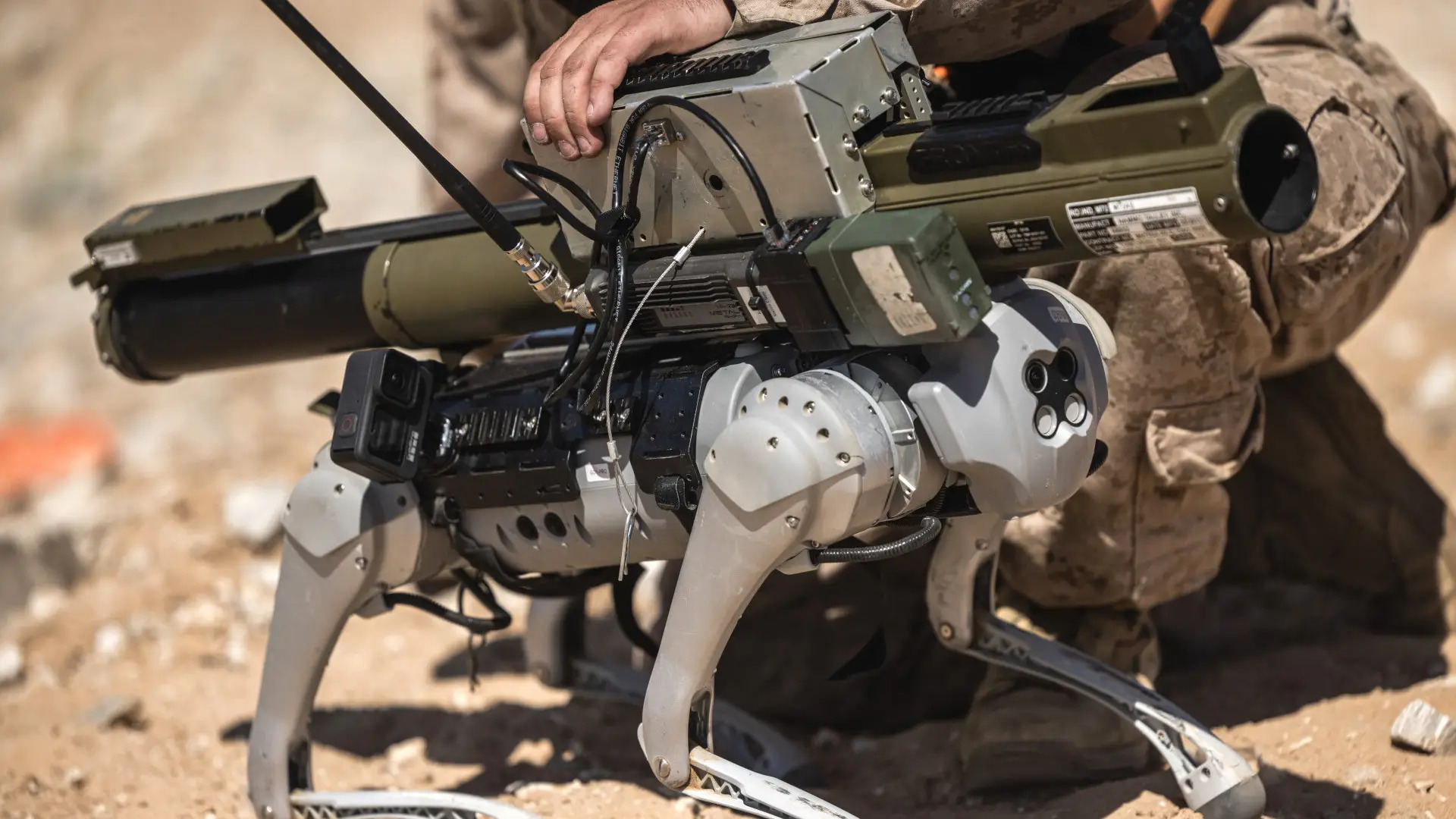The US Marine Corps (USMC) tested an armed ‘robotic canine’ that can team up with an infantry team. The ‘war dog’ can also fire a rocket. It shares similarities with the ‘Spot’ autonomous system from Boston Dynamics. Yet, it was Chinese, available off-the-shelf on e-commerce portals.
Developed by a Chinese private technology industry, the robotic dog system is merely a “proof of concept” exercise for the USMC. This does not suggest the US is set to mass acquire the Chinese system and induct it immediately into its ground forces. The activity was undertaken to determine whether the armed robotic system offers some viability in actual combat.
This exercise is different than an under-development weapons systems testing that the US Department of Defense (DoD) or Congress has funded in various private defense firms upon a specific request by its military. These latter see formal acquisition through final performance, technical trials, and financial bids as a part of a tendering process.
In other words, if the US decides to officially acquire such a system to be fused with the USMC’s order of battle (ORBAT), it would be a US-made robot or at least one developed by an ally like the UK, Canada, or Japan.
This will be after extensive tests of the existing systems in the market — possibly the Chinese one — to finalize the performance and technical requirements. This will be followed by a Request for Information (RFI) and, later, a Request for Proposal (RFP), inviting bids from the private defense industry.
Chinese Robot Dog Tested By US Marine Corps
The USMC released publicity material and video showing the robot, a Chinese-made Unitree Go1 “quadrupedal” system. It demonstrated its various mobility, maneuvering, and load-carrying capabilities, eventually firing the M72 Light Anti-Tank Weapon (LATW) from its back.
The test was held on September 9 at the Marine Corps Air-Ground Combat Center, Twenty-nine Palms, California. Scientists with the Office of Naval Research (ONR) were also present during the exercise.

The Unitree Go1 is available for purchase online, including through Amazon. Unitree’s website offers the baseline Go1 Air for $2,700 and the Go1 Pro. The latter, priced at US$3,500, is advertised to possess more capable sensors for general movement and object recognition.
The USMC called the drill a “proof-of-concept range for the Robotic Goat,” where the “goat can carry different payloads and was testing its ability to acquire and prosecute targets with the M-72 Light Anti-Tank Weapon.” It is unclear why the Corps chose the term “Robotic Goat” instead of the universally accepted “dog.”
The video shows a Marine controlling the Go1 with a console, exhibiting its various stationary and movement functions, demonstrating an ability to control and balance obstacles and uneven terrain.
However, it is unclear if the robot is also capable of semi-autonomous or fully autonomous operation. The website describes it as the world’s first “intelligence bionic quadruped robot” developed for “robot fans, education and scientific research.” That it does not represent the machine as ‘Artificial Intelligence’ — as it does for the advanced Unitree Go2 — suggests it is semi-autonomous, requiring some level of human intervention.
While the robot does fire the LAW towards the end of the video, it does so from a static, fixed position with sandbags on either side for safety. A Marine later removes the launcher from the mount, showing how the system might be reloaded in the field. A report on The Drive said the launcher appears to be an “M72AS trainer, firing a 21-millimeter rocket with a tracer element in the rear.”
Takes Load Off The Infantryman
The system, although far from technically and tactically refined for military use that caters to the attendant technological and logistical problems on a physically harmful battlefield, still has benefits in easing the infantryman’s many roles that armies struggle with. For one, it does offer relief in tasks that cannot be completed owing to the limits of human endurance.
The robot can come in handy in situations requiring tactical firing while navigating rough terrains but has to be either curtailed or called off owing to absolute physical exhaustion. Suppose the operational procedures of remotely operating the robot and tactics are thoroughly practiced; it can perform diverse infantry roles where high casualties are guaranteed but need to be undertaken nonetheless.
Some tasks include approaching enemy fortifications while firing, denying a particular area to the enemy while continuing to lay down fire, and undertaking the dangerous job of firing rockets at enemy armor while being dismounted from armored carriers.
Needs Work But Effective
A retired Brigadier-rank officer, who was also an instructor at the Indian Army’s Counter-Insurgency and Jungle Warfare School (CIJWS), told EurAsian Times that dedicated unmanned combat ground vehicles (UGV) may be technologically challenging but offer “simple yet effective” advantages like “fire accuracy” during intense combat situations.
“The robot the USMC tested is a civilian leisure one. But the ones made specifically for military use will have robust gun stabilizing mounts that will nearly hit all targets in a few rounds, saving ammunition, time, and energy.
“They would also be ruggedized, helping in inhospitable terrains like jungles and mountains (or sometimes both), where certain land features simply cannot be traversed owing to the insurmountable environmental factors.
“The robot managing to take an unorthodox firing position by climbing the last few meters of a near vertical peak in sub-zero temperatures or wading through intense foliage during heavy rainfall in a tropical jungle can help keep up the pressure on the enemy,” the officer explained.
The same is valid for urban warfare — an environment heavily skewed in the defender’s favor — where the machine can crawl and contort its body through extremely confined and narrow spaces of collapsed buildings and debris. Even a non-weaponized, surveillance-oriented robot dog can benefit the occupying army tremendously.
Chinese Army Already Ahead In Testing Robot Dogs
China’s People’s Liberation Army (PLA) has also tested several such bionic robots based on the videos released on its state-run media. Grabs of a news feature from China Central Television (CCTV) showed PLA soldiers practicing using small tracked and bionic dog robots in an urban warfare training area.
2/4
As previously shown in other drills, the unmanned equiment was used in coordination with other unmanned vehicles, with infantry, IFVs and helicopters (most likely 🇨🇳Z-8 transport & Z-10 attack helicopters, see last photo tweet above) and in urban environments pic.twitter.com/XkZ6F891Hw— Jesus Roman (@jesusfroman) June 7, 2022
One picture shows the robotic dog ahead of a team on the staircase while breaching a building, suggesting it is being used as a scout. The USMC video shows the robotic dog can manipulate its joints and legs at multiple axes. Using this ability, a quick peek inside a building’s corridor or gangway and beaming back the image to the breaching team reveals its layout and helps rapidly devise a plan for a door-to-door clearing.
Jesus Roman, a leading Chinese military watcher on X (formerly Twitter), identified the robot as Blood Wing, which he said has appeared in several prior PLA drills. “(It is seen carrying) multiple payloads from smoke launchers to squad weapons or sensors in urban environments,” he said in a thread from June 2022.
Another video showed the Blood Wing being deployed as a drop package by what appears to be a heavy-lift multirotor UAV on the rooftop of a building. After the UAV flies away, the robotic dog deploys from its folded position and moves while carrying a light machine gun.
- The author can be reached at satamp@gmail.com
- Follow Eur Asian Times on Google News




